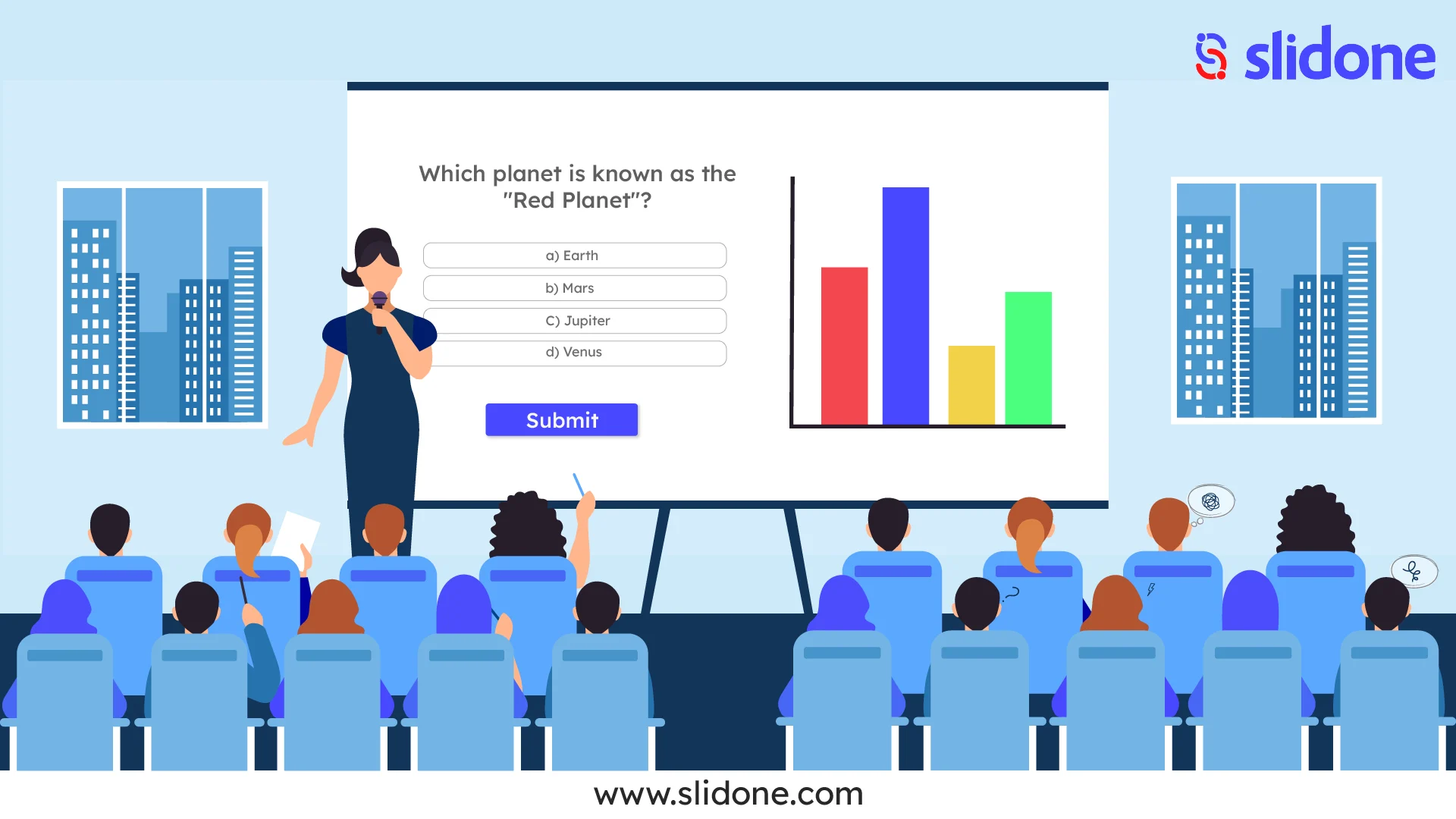It is not easy to do presentations, and they are even more difficult when the audience does not say anything. The spiral of silence occurs when people do not want to talk in a presentation because they are afraid of evaluation, rejection, or their opinions differ from others. This usually creates a boring, uninterested atmosphere where it will be even harder for the presenter to win the audience over. In this blog, we will see how to break this vicious circle and come out with a more participatory and engaging atmosphere of a presentation.
What is the Spiral of Silence?
The Spiral of Silence, developed by the German political scientist Elisabeth Noelle-Neumann in 1974, describes the phenomenon when an individual makes a decision to remain silent after perceiving their views are in the minority. With this theory, it has been shown that people often do not voice opinions when they feel they are in opposition to the majority but give way to an ongoing process of silence. The more people that hold back, the fewer others will be to speak up, creating a self-reinforcing spiral of silence. For example, in presentations, when participants don’t ask questions and give feedback because they think their contributions may fall on deaf ears, be criticized, or be unimportant, this kills the open discussion of an event which offers the potential expression of diverse viewpoints that can make the event less interesting and less productive for all who are involved.
Why Does It Happen?
Some causes give rise to the spiral of silence during the presentation. The greatest determinant involves the fear of embarrassment, whereby members of the audience may believe their question may portray them as uninformed. Another cause is the assumption that somebody else will speak later since most individuals prefer silence believing another participant will ask the same question they have. Except for this, such a factor as the absence of contact between the speaker and the audience can provide a basis for this phenomenon. If the speaker fails to involve the audience into a certain interactive process, participants in their turn may feel uninvolved and demonstrate reluctance to say anything at all. Such a combination of fear, assumptions, and being disengaged can bring about an absence of audience participation and questions during presentations.
Easy Tips to Break the Spiral of Silence
1. Engage Early with Your Audience
Do an Icebreaker
Most good presentations begin with audience engagement right out of the gate. A great way to get started is with a fun and easy icebreaker question. You might ask something like, “Who in the room has experience with today’s topic?” or “What is one thing you hope to take away from today?” These types of questions begin to engage the audience immediately and set the session up to be an interactive environment.
Use Polls and Surveys
It would be really useful to make this whole engagement more effective with the help of live polling platforms. This tool will enable you to gather feedback from your audience in real time for such a purpose. It will give the shiest participants the opportunity to vote anonymously without having a fear of judgment. Hence, not only would more people get engaged, but you would get some useful input about what they think and want, which might be used to adapt the presentation accordingly.
You can maintain a positive tone in your presentation through the use of an engaging icebreaker to begin with, followed by the incorporation of polls and surveys to get more people involved.
2. Create a Safe and Supportive Environment
Welcome All Questions
Conditions need to be created for everyone to feel free enough to ask questions. From the very start, let people know that no question is too insignificant, no question is too small. You can say something like, “There are no bad questions here. If you’re thinking about it, others likely are too.” This method is instrumental in the nurturing of an environment where participants view themselves and each other as supportive and valuable.
Positive Treatment of Silence
Sometimes, after asking a question, you might get no response. It is very important not to assume that this indicates a lack of interest. On the contrary, respond positively to the silence with comments like, “It’s great to see everyone thinking deeply about the topic.” At times, silence means that people actually think deep and are just processing the question. You might rephrase the question in an even simpler question format, for instance “What part of this resonates with you?” This allows the question to be more accessible in a learning space.
Lean Into Calling on Individuals
When nobody volunteers and the silence lingers on, do not hesitate to call people out, but in a manner that is non-threatening. You may say, “John, I know you have faced this problem previously. Can you share your view?” It opens them up for others to contribute since it is personalized. You allow some interactivity in discussion by doing so without stepping on any toes, which can lead to more vital exchanges and inputs from all participants.
3. Encourage Group Discussions
Small Group or Pair Work
Then, divide the audience into small groups or in pairs to discuss certain topics. Many people feel very comfortable making their views known when the setting is small. Give them time to discuss, then ask for volunteers from each group to share with the whole group. This gets rid of the pressure that creates initial silence.
Open-ended Questions
Instead of asking yes/no questions, use open-ended ones that would encourage a little more elaborate responses. For example, instead of asking, “Do you agree with this point?” ask, “What are your thoughts on this approach?” Open-ended questions allow for in-depth discussions and different perspectives to come out. This not only improves the discussion but also provides more participation by the members.
4. Use Body Language and Tone Effectively
Open, Friendly Body Language
Your body language speaks volumes about you and how your audience will perceive and receive you. Create a positive and engaging atmosphere through your open and approachable stance. That means standing with your shoulders back, arms relaxed at your sides rather than across your chest, smiling, and making eye contact to establish a connection with your audience. It can be a very powerful tool to use hand gestures, to point to some important aspect or give emphasis to the message. Avoid standing rigidly or adopting a defensive posture, which may involuntarily create some barrier between you and your listeners.
Speak With Enthusiasm
Of great importance, of course, is how you use your voice. A monotone will surely result sooner or later in your audience’s loss of interest. Establish variations in pitch and pace to keep the audience’s attention and to show your enthusiasm. This emphasis on important points in an energetic and vivacious manner holds listeners’ attention and makes what you are saying more memorable. Speaking with true enthusiasm not only makes your presentation more appealing but also fosters participation and interaction. You will make the experience so much more dynamic for your audience by mixing a warm, open posture with a lively delivery vocally.
5. Use Interactive Presentation Tools
Incorporate Technology
Engagement can be significantly improved by using technology when creating presentations, such as for virtual or hybrid formats.The interactive presentation tools that allow live polls, quizzes, and Q&A sessions. Such tools help in providing a way for audience members to give their opinions anonymously for instances where participation in more cases compared to having only a few people speak up.
Gamify the Experience
It can also serve to enhance the presentation experience by adding features like interactive quizzes or challenges that can transform a passive audience into an active one. Think of a live quiz that tests the audience’s knowledge while giving small prizes for correct answers; it adds fun and competitiveness to the session. This works to encourage contributions and the sharing of thoughts about the content, turning a quiet audience into enthusiastic contributors.
These strategies put together mean that presentations will be more dynamic and interactive, therefore creating an environment that is even more engaging and participatory.
Conclusion: Breaking the Silence
The spiral of silence can be a barrier to the success of your speech, but you are not helpless. First, get your audience on board right from the start. Establish a non-threatening climate and avail yourself of interactive tools promoting participation. Your body language, tone and technical support can all serve to put your audience at ease about expressing themselves. The silence, of course, is hard to overcome; however, with an unflinching promotion of dialogue, your presentation will be a more engaging and dynamic experience. As Albert Einstein captured it, “The measure of intelligence is the ability to change,” and dialogue is precisely one important change leading you to a successful presentation.





Leave a Comment
Your email address will not be published. Required fields are marked *